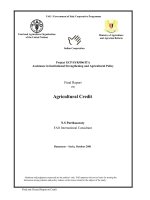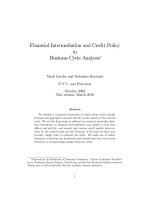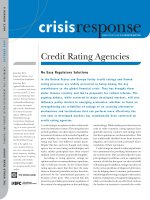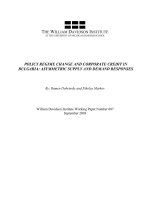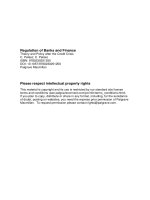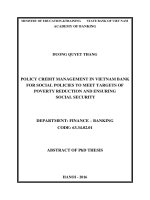Analyzing credit policy
Bạn đang xem bản rút gọn của tài liệu. Xem và tải ngay bản đầy đủ của tài liệu tại đây (42.55 KB, 1 trang )
Analyzing Credit Policy
Credit Policy Effects
1) Revenue Effects
Delay in receiving cash from sales
May increase total sales
2) Cost Effects
Cost of the sale is still incurred even though the cash from the sale has not been received
Cost of debt: must finance receivables
Probability of nonpayment: some percentage of customers will not pay for products purchased
Cash discount: some customers will pay early and pay less than the full sales price
Evaluating a Proposed Credit Policy
1)
Price per unit (P)
Variable cost per unit(v)
Current quantity sold per month(Q)
Quantity sold under new policy(Q’)
Monthly required return(R)
NPV of Switching Policy
Your company is evaluating a switch from a cash only policy to a net 30 policy. The price per
unit is $100, and the variable cost per unit is $40. The company currently sells 1,000 units per
month. Under the proposed policy, the company expects to sell1,050 units per month. The
required monthly return is 1.5%.
What is the NPV of the switch?
Incremental cash inflow = (P-v) (Q' -Q) = (100– 40) (1,050 – 1,000) = $3,000
Present value of incremental cash inflow = [(P– v) (Q'– Q)]/R = 3,000 ÷ .015 = $200,000
Cost of switching = PQ + v*(Q'– Q) = 100(1,000) + 40(1,050– 1,000) = 102,000
NPV of switching = - [PQ + v (Q'– Q)] + [(P – v) (Q'– Q)]/R = 200,000– 102,000=98,000
Should the company offer credit terms of net 30?
Yes, the company should switch
2) A Breakeven Application
What increase in unit sales is necessary to break even?
NPV = 0 = - [PQ + v (Q'– Q)] + [(P–v) * (Q'– Q)]/R
Q'–Q = PQ/ [(P – v) ÷ R– v] = 100,000/ [(100-40)/.015-40]
= 25.25 unit

